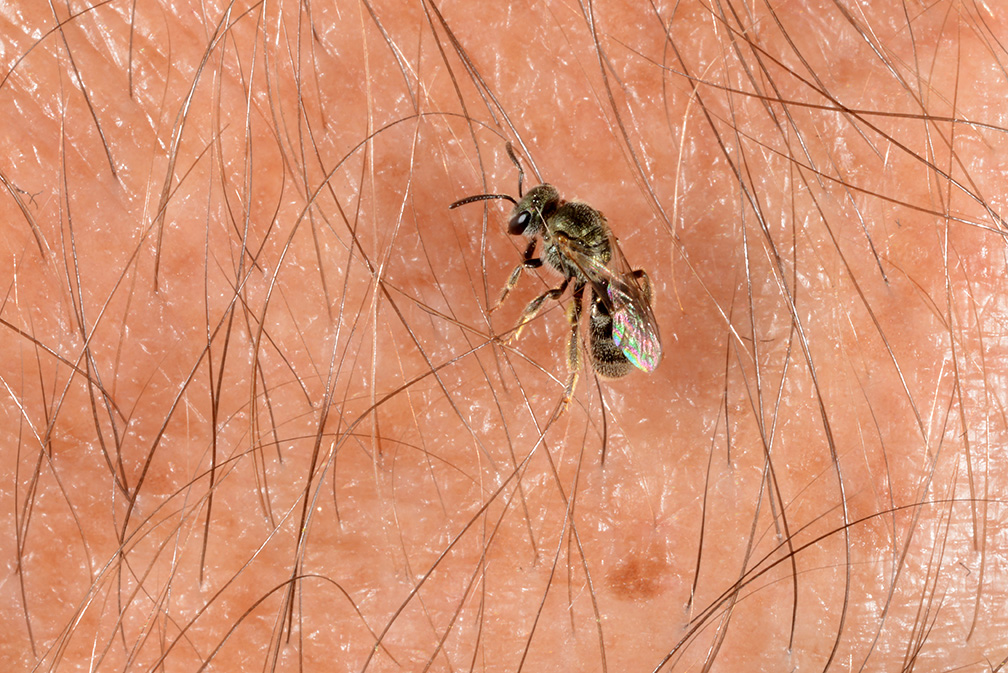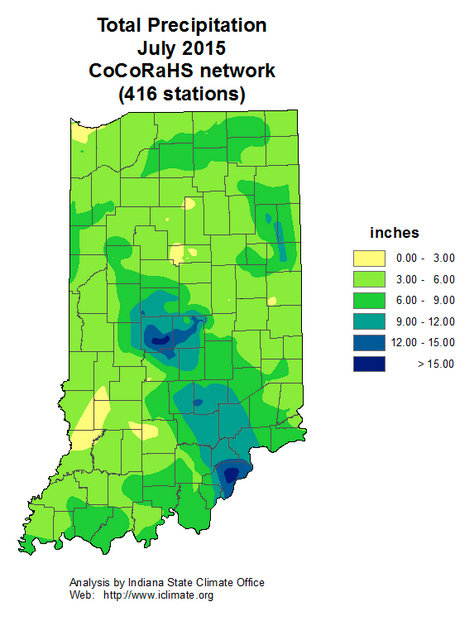
Pest & Crop
Newsletter
Purdue Cooperative Extension Service

Purdue Cooperative Extension Service
Issue 19, August 6, 2015 • USDA-NIFA Extension IPM Grant
CLICK HERE FOR A PDF VERSION OF THIS ISSUE ![]()
Over the last couple of weeks, many out-of-focus pictures and videos of multitudes of looping worms crawling over high-boy equipment that has recently been through corn fields. What were these things? Were they eating the corn? How do we kill them? The best we could determine, especially with the grainy video, was that the worms are actually maggots – fly larvae. The only maggots found in cornfields this time of the year are syrphid fly larvae, which are predators of soft-bodied insects, especially aphids. So these are good guys in action! This probably indicates that the fields are loaded with aphids, probably corn leaf aphids or bird cherry oat aphids. Both are common and usually not an important pest.
This week we received additional reports of large numbers of “sweat bees” in and around cornfields. The adult syrphid is commonly referred to as the hover fly. Hover flies are bee and wasp mimics and are often orange, black or yellow with banding patterns – this helps protect them from predators that confuse them with more hazardous food items. They cannot sting and are harmless. Sweat bees, on the other hand, are actually bees and have stingers. They are smaller and are typically dark or metallic in color. Both hover flies and sweat bees are attracted to us for the moisture and salts they get by lapping up our sweat. Sweat bees will sting if we accidently squish/swat them on our skin while they are feeding. However, they will sometimes sting even when they are not bothered at all; they are spiteful that way.
Though we have not seen, nor had reported, large numbers of aphids in cornfields this season, we can deduce that there are large populations in some fields because of the high syrphid fly numbers. Their numbers typically build in late summer and early fall, so if you haven’t seen them yet, you likely will soon. So during some upcoming field days, impress wagon loads of attendees with your knowledge of wasps, hover flies and sweat bees. Just make sure you know the difference before trying to catch one.

Syrphid larvae among corn anthers.

Syrphid fly on skin, notice bee like coloration.

Syrphid, or hover fly holding steady over a flower.

Sweat bee on skin, notice wings folded over abdomen.
| County | Cooperator | WBC Trapped | ||||||
|---|---|---|---|---|---|---|---|---|
| Week 1 6/18/15 - 6/24/15 |
Week 2 6/25/15 - 7/1/15 |
Week 3 7/2/15 - 7/8/15 |
Week 4 7/9/15 - 7/15/15 |
Week 5 7/16/15 - 7/22/15 |
Week 6 |
Week 7 7/30/15-8/5/15 |
||
| Adams | Kaminsky/New Era Ag | 0 | 0 | 0 | 2 | 3 | 1 | 0 |
| Adams | Roe/Mercer Landmark | 0 | 0 | 0 | 0 | 0 | 2 | 0 |
| Allen | Anderson/Syngenta Seed | 0 | 0 | 0 | 5 | 3 | 7 | |
| Allen | Gynn/Southwind Farms | 0 | 0 | 1 | 2 | 12 | 7 | |
| Allen | Kneubuhler/G&K Concepts | 0 | 0 | 0 | 0 | 5 | 2 | 0 |
| Bartholomew | Bush/Pioneer Hybrids | 0 | 0 | 0 | 0 | 0 | 0 | 0 |
| Boone | Campbell/Beck's Hybrids | 0 | 0 | 0 | 0 | 0 | 0 | 0 |
| Clay | Bower/Ceres Solutions/Brazil | 0 | 0 | 0 | 0 | 0 | 0 | |
| Clay | Bower/Ceres Solutions/Bowling Green | 0 | 0 | 0 | 0 | 0 | 0 | |
| Clinton | Emanuel/Boone Co. CES | 0 | 0 | 0 | 1 | 1 | 0 | |
| Clinton | Foster/Purdue Entomology | 0 | 0 | 0 | 5 | 0 | 0 | |
| DeKalb | Hoffman/ATA Solutions | 0 | 0 | 10 | 114 | 12 | 6 | |
| Dubois | Eck/Purdue CES | 0 | 0 | 0 | 0 | 1 | 0 | 0 |
| Elkhart | Kauffman/Crop Tech Inc. | 1 | 1 | 0 | 59 | 89 | 4 | 0 |
| Fayette | Schelle/Falmouth Farm Supply Inc. | 0 | 0 | 0 | 0 | 0 | ||
| Fountain | Mroczkiewicz/Syngenta | 0 | 0 | 14 | 52 | 2 | 0 | 0 |
| Fulton | Jenkins/N. Central Coop-Rochester | 0 | 2 | 262 | 679 | 701 | 36 | |
| Fulton | Jenkins/N. Central Coop-Kewana | 1 | 2 | 121 | 595 | 362 | 42 | |
| Gibson | Schmitz/Gibson Co. CES | 0 | 0 | 0 | 0 | 0 | 1 | |
| Hamilton | Campbell/Beck's Hybrids | 0 | 0 | 0 | 0 | 0 | 0 | 0 |
| Hamilton | Truster/Reynolds Farm Equipment | 0 | 0 | 0 | 0 | 0 | 1 | 0 |
| Hendricks | Nicholson/Nicholson Consulting | 0 | 0 | 0 | 0 | 1 | 0 | |
| Henry | Schelle/Falmouth Farm Supply Inc., Millville | 0 | 0 | 0 | 0 | 0 | ||
| Jasper | Overstreet/Purdue CES | 0 | 0 | 2 | 51 | 64 | 12 | 2 |
| Jasper | Ritter/Brodbeck Seeds | 1 | 0 | |||||
| Jay | Boyer/Davis PAC | 0 | 0 | 0 | 0 | 0 | ||
| Jay | Shrack/Ran Del Agri Services | 0 | 0 | 0 | 0 | 0 | 0 | 0 |
| Jay | Temple/Jay County CES | 2 | 0 | |||||
| Jennings | Bauerle/SEPAC | 0 | 1 | 0 | 0 | 0 | 0 | 0 |
| Knox | Bower/Ceres Solutions/Freelandville | 0 | 0 | 0 | 0 | 0 | ||
| Knox | Bower/Ceres Solutions/Vincennes | 0 | 0 | 0 | 0 | 0 | ||
| Knox | Bower/Ceres Solutions/Frichton | 0 | 0 | 0 | 0 | 0 | ||
| Lake | Kleine/Kleine Farms | 0 | 2 | 14 | 7 | 4 | 6 | |
| Lake | Moyer/Dekalb Hybrids, Shelby | 0 | 2 | 7 | 19 | 165 | 13 | 0 |
| Lake | Moyer/Dekalb Hybrids, Schneider | 1 | 0 | 4 | 67 | 456 | 76 | 12 |
| LaPorte | Rocke/Agri-Mgmt Solutions, Wanatah | 0 | 5 | 74 | 141 | 142 | 10 | 8 |
| LaPorte | Rocke/Agri-Mgmt Solutions, LaCrosse | 0 | 2 | 135 | 350 | 110 | 5 | 5 |
| Miami | Early/Pioneer Hybrids | 0 | 6 | 141 | 86 | 7 | 0 | |
| Miami | Myers/Myers Ag Service | 2 | 1 | 9 | ||||
| Montgomery | Stine/Nicholson Sonsulting | 0 | 0 | 0 | 11 | 3 | 0 | 0 |
| Newton | Moyer/Dekalb Hybrids, Lake Village | 0 | 1 | 3 | 13 | 38 | 8 | 1 |
| Porter | Leuck/PPAC | 0 | 1 | 10 | 56 | 87 | 4 | 2 |
| Putnam | Nicholson/Nicholson Consulting | 0 | 0 | 0 | ||||
| Randolph | Boyer/DPAC | 0 | 0 | 0 | 2 | 0 | ||
| Rush | Schelle/Falmouth Farm Supply Inc. | 0 | 0 | 0 | 0
|
0 | ||
| Shelby | Simpson/Simpson Farms | 0 | 0 | 2 | 0 | 1 | 0 | |
| Sullivan | Bower/Ceres Solutions/Sullivan | 0 | 0 | 3 | 2 | |||
| Tippecanoe | Bower/Ceres Solutions | 2 | 15 | 30 | 15 | 2 | ||
| Tippecanoe | Nagel/Ceres Solutions | 0 | 0 | 0 | 1 | 0 | ||
| Tippecanoe | Obermeyer/Purdue Entomology | 0 | 0 | 0 | 1 | 0 | 0 | |
| Tippecanoe | Westerfeld/Monsanto | 0 | 0 | 0 | 0 | 0 | 0 | 0 |
| Whitley | Walker/NEPAC | 0 | 0 | 2 | 47 | 119 | 49 | |
July rainfall combined with June's historic rains to turn the two months into the second-wettest June and July on record in Indiana, according to the Indiana State Climate Office.
Rainfall during six weeks from about June 7 to July 21 totaled 15.09 inches, said the climate office, based in Purdue University's Department of Agronomy. The wettest June-July was in 1958, when 16.15 inches of rain fell in Indiana.
A preliminary statewide total of 6.05 inches of rain fell in Indiana in July, ranking the month as the seventh-wettest July since records began in 1895. The wettest July was in 1992 with 8.55 inches.
The hardest-hit areas in July were generally in two-county bands of Hendricks and Marion in central Indiana, and Clark and Jefferson in the southeast portion of the state. The heaviest reported rainfall was 17.65 inches in a Clark County monitoring station in Charlestown, noted Ken Scheeringa, associate state climatologist.
June set a record as the wettest June in Indiana at 9.04 inches. That exceeded the previous record of 8.13 inches in 1958.
A major cause of the six-week rain pattern was high pressure, anchored in the southeastern states, that deflected incoming storm systems to Indiana, the climate office reported. Storms originated in the Texas area on the west edge of the high-pressure system, containing large amounts of moisture from the Gulf of Mexico.
Since about July 21, however, upper atmosphere high pressure has expanded coast to coast across the southern states, cutting off the relentless moving of moisture from the Gulf.
"This new wind flow path has since returned Indiana to a likelihood of a more normal summer rainfall pattern," said State Climatologist Dev Niyogi.
The outlook for the remainder of August is for equal chances of below-, normal- or above-normal temperature and precipitation in Indiana. The early part of the month is expected to be much cooler and drier than normal, with a possible moderation in both temperature and precipitation in the middle and latter parts of the month.

Purdue Extension Entomology
901 W. State Street
West Lafayette, IN, 47907
(765) 494-8761
luck@purdue.edu
@PurdueExtEnt
PurdueEntomology

If you would like to be alerted by e-mail when the current issue of the Pest&Crop is available on-line, please enter your e-mail address and click the submit button.
It is the policy of the Purdue University Cooperative Extension Service that all persons have equal opportunity and access to its educational programs, services, activities, and facilities without regard to race, religion, color, sex, age, national origin or ancestry, marital status, parental status, sexual orientation, disability or status as a veteran. Purdue University is an Affirmative Action institution. This material may be available in alternative formats.